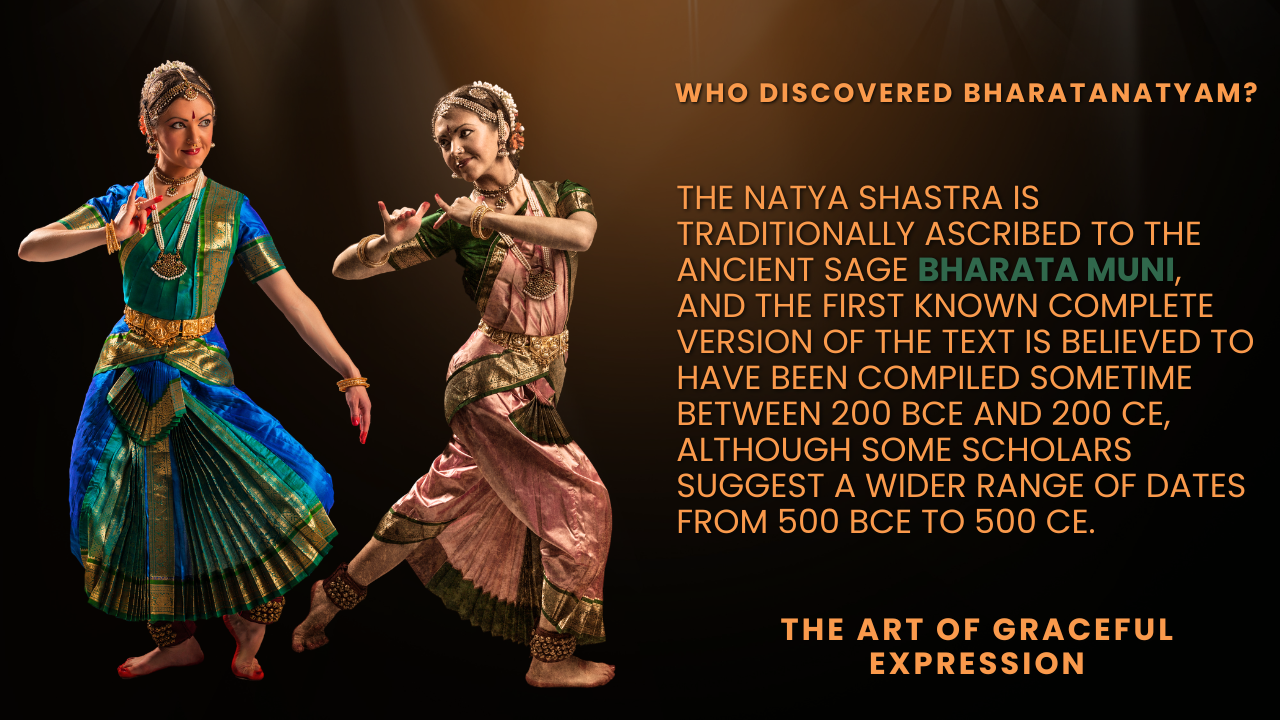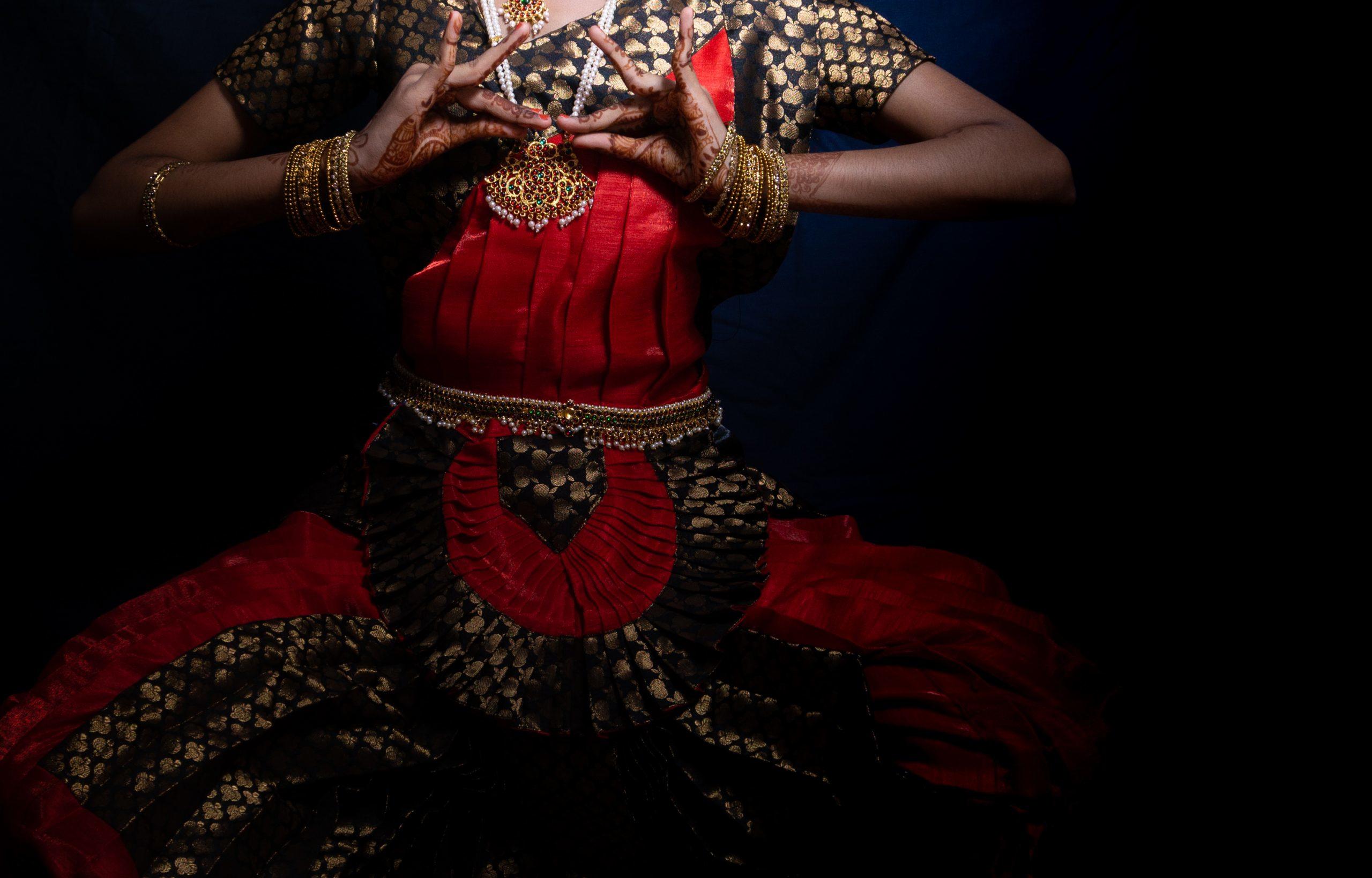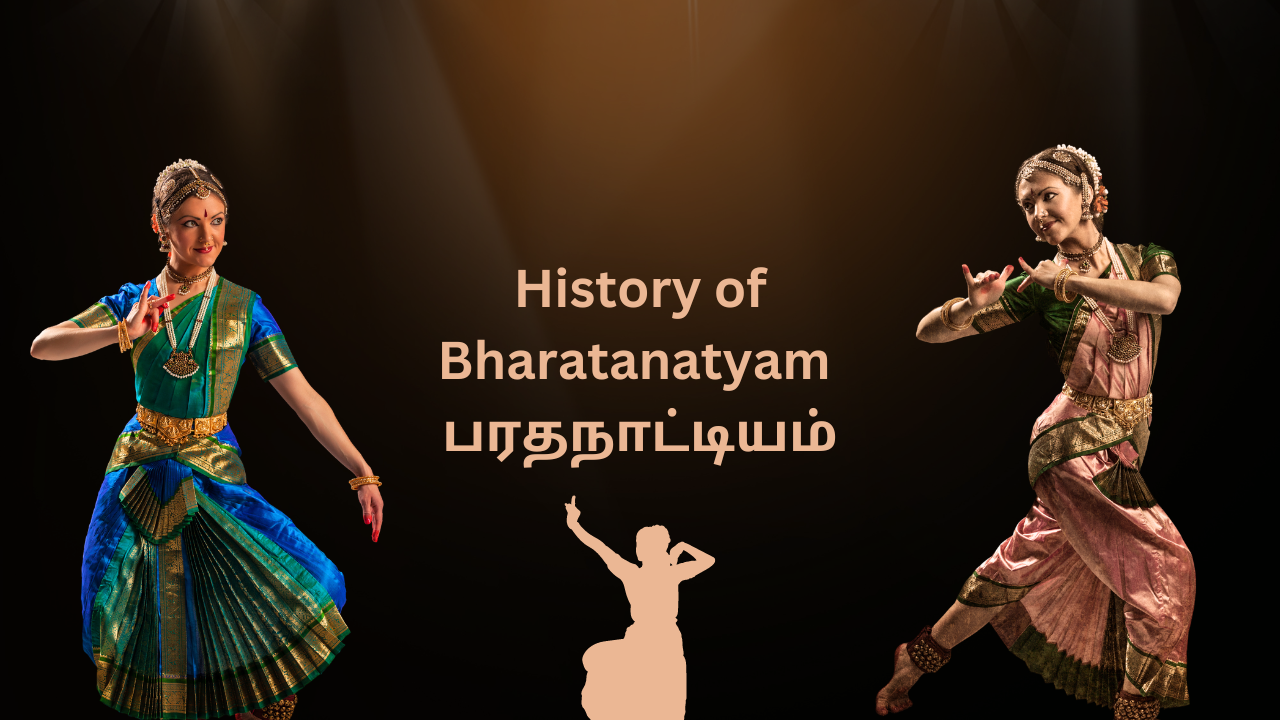Bharatanatyam is one of India’s oldest and most revered classical dance forms. This article explores the origin and history of Bharatanatyam, tracing its journey from ancient temple rituals in Tamil Nadu to its place on modern stages around the world.
However, what is the story of the origin of Bharatnatyam?
It is the oldest classical dance tradition in India, has its roots in the Natya Shastra from around 500 BCE and the ancient Tamil epic Silappatikaram from around 171 CE. Temple sculptures from the 6th to 9th century CE indicate that dance had become a refined performance art by the mid-1st millennium CE.
Originally known as Sadiraattam, Bharatanatyam was renamed in 1932 and is now the state dance form of Tamil Nadu. The dance form encompasses different types of bani, which refer to specific dance techniques and styles associated with a guru or school. Bharatanatyam is characterized by a fixed upper torso, bent legs, and flexed knees (Aramandi), along with intricate footwork and a vocabulary of hand, eye, and facial gestures.

What is the meaning of the Bharatanatyam dance?
The term Bharatanatyam is a combination of two Sanskrit words: 'Natyam' which means dance, and 'Bharata' which is a mnemonic consisting of 'Bha' (bhava/emotions), 'Ra' (raga/melody), and 'Ta' (tala/rhythm). Therefore, Bharatanatyam refers to a dance form that embodies Bhava, Raga, and Tala.
The southern Indian state of Tamil Nadu is home to the Bharatanatyam dance. Its roots can be found in the Natyashastra, an antiquated play about theater penned by the legendary priest Bharata. The origin of Bharatanatyam as a temple dance for women is frequently employed to convey Hindu religious tales and devotions. It wasn't until the 20th century that it was frequently performed in public.
In Bharatnatyam, the feet maintain rhythm while the legs are bowed, defining the dancing moves. A narrative can be conveyed by the use of hands in a sequence of mudras, or symbolic hand movements.
Bharatnatyam Origin
Bharatanatyam is the oldest classical dance style in India, having its roots in Tamil Nadu. It was formerly known as Sadhir Attam. The temple dance known as Bharatanatyam narrates tales from several Hindu scriptures. These days, Bharatanatyam is a dance form that incorporates fusion styles along with themes that are both sacred and secular.
Bharatanatyam, originating from Tamil Nadu, is a traditional dance form with a history of over 2000 years.
The theoretical foundation of this dance style, also known as Sadir, may be found in the Sanskrit Hindu classic "Natya Shastra," an ancient work on performing arts written by Indian theatrologist and musicologist Bharata Muni.
The Hindu tradition states that the name of the dance form was created by combining the words "Bharata" and "Natyam," where "Natyam" means dance and "Bharata" is a mnemonic made up of the words "bha," "ra," and "ta," which stand for "bhava," which is emotion and feelings, "raga," which is melody, and "tala," which is rhythm. As a result, the word originally described a style of dance in which bhava, raga, and tala are represented.
The earliest complete edition of the text was probably finished between 200 BCE and 200 CE, while this range also includes 500 BCE and 500 CE. Legend has it that Lord Brahma taught the sage Bharata about Bharatanatyam, and Bharata subsequently inscribed this sacred dance form in Natya Shastra. The book splits dance into two categories: "nrita," which is a pure dance made up of delicate hand gestures and motions, and "nritya," which is a solo expressive dance made up of expressions.

A direct allusion to this dancing style may be found in "Silappatikaram," one of the five great epics of Tamil literature, written in the second century CE. The evolution of this dance form by the middle of the first millennium CE is demonstrated by the carvings on the exterior of the Shiva temple at Kanchipuram, which date from the sixth to the ninth century CE. Statues of Lord Shiva in Bharatanatyam dance positions adorn numerous historic Hindu temples.
The finely carved tiny rectangular panels in the eastern gopuram of the 12th-century Thillai Natarajar Temple in Chidambaram, Tamil Nadu, honor Lord Shiva. The panels portray 108 Bharatanatyam stances, also known as karanas in "Natya Shastra." Another noteworthy sculpture is found in the 7th-century Badami cave temples in Karnataka's Cave 1, where a five-foot-tall sculpture of Lord Shiva is shown as Nataraja doing a Tandava dance. The Shiva sculpture's eighteen arms represent Bharatanatyam hand movements or mudras.
Who invented Bharatanatyam?
Did you know? Vazhuvoor (also known as Vizhuvur) is among the traditional forms of Bharatanatyam, a prominent genre of Indian classical dance. Its key distinguishing characteristics consist of elaborate sringar elements.
Sankardev is credited with creating and refining the classical Indian dance form known as Sattras. According to belief, Bharatnatyam was disclosed to Bharata, a renowned sage, by Lord Brahma, who then documented this sacred dance in a Sanskrit text called the Natya Shastra.
Learn Bharatnatyam dance and other forms of Indian dance through dance classes in Delhi through Superprof.

7 Stages Of Bharatanatyam: Sequence
The Margam in Bharatnatyam comprises seven distinct styles that dictate the sequence of the performance:
Pushpanjali, Alarippu, Jatiswaram, Shabdam, Varnam, Padam, and Tillana.
These seven styles collectively form the entirety of the Bharatnatyam dance tradition.
Pushpanjali (Flower Offering)
This is the opening segment of a Bharatnatyam performance. It begins with the dancer offering flowers to the deities and seeking their blessings. Pushpanjali sets a spiritual and devotional tone for the dance.
Alarippu (Flourishing)
Alarippu is a pure dance piece that focuses on rhythm and movements. It is characterized by fast footwork and intricate patterns that showcase the dancer's skill and agility. The purpose of Alarippu is to prepare the dancer's body and mind for the more expressive sections that follow.
Jatiswaram (Pure Dance)
Jatiswaram is another pure dance piece, but it incorporates musical notes and syllables. It is often devoid of lyrics and is more about showcasing the dancer's command over complex rhythmic patterns. It is an abstract and technical part of the performance.
Shabdam (Expressive Dance)
Shabdam marks the transition from pure dance to expressive dance. In this segment, the dancer introduces lyrics and begins to convey a narrative or express emotions. The piece is typically set to a Carnatic music composition.
Varnam (Main Piece)
Varnam is the central and most elaborate section of a Bharatnatyam performance. It combines intricate footwork, expressive abhinaya (facial expressions), and complex rhythms. Varnam often tells a story, often a mythological or devotional one, and is considered the highlight of the performance.
Padam (Lyrical Dance)
Padam is a slower and more lyrical piece in the performance. It focuses on expressing emotions, often love or devotion, through intricate facial expressions and hand gestures. The lyrics are usually romantic or devotional in nature.
Tillana (Fast-paced Dance)
The Tillana is the concluding part of a Bharatnatyam performance and is characterized by its brisk and energetic movements. It combines intricate footwork, fast-paced music, and lively expressions. Tillana is a vibrant and joyful way to conclude the dance recital.
Influence of Devadasi Culture
Bharatanatyam quickly became popular in other South Indian temples after starting out in Hindu temples in Tamil Nadu and the surrounding areas. Some historians claim that the Devadasi culture, which dates back to about 300 BCE and 300 CE, developed under the patronage of the royals and witnessed the performance of the dance style by temple dancers known as Devadasis, who were devoted to serving the Lord as dasis, or slaves.
The Devadasi tradition eventually found its way into South Indian temple rites. Davesh Soneji, a performance art historian and specialist in Bharatanatyam, has concluded that the courtesan dancing phenomena started in Tamil Nadu during the Nayaka period, possibly in the late 16th or early 17th century.
Colonial Era Ban
The East India Company began to govern India in the 18th century, and British colonial rule was established in the 19th century. Many classical dance styles, such as Bharatanatyam, which was restricted to Hindu temples throughout the 19th century, were mocked and discouraged. Such systems were eventually shamed by the social and economic circumstances connected to Devadasi culture.

In addition, Bharatnatyam attracted the scorn and deplorable attitude of Christian missionaries and British officials who viewed the Devadasis of South India and the nautch girls of North India as harlots. n fact, Christian missionaries started an anti-dance movement in 1892. The ancient practice of performing Bharatanatyam in Hindu temples was discontinued in 1910 when the Madras Presidency, a British colonial administration, outlawed dancing in Hindu temples.
Revival
Classical art revivalists quickly got to work to bring the art form back to life. E. Krishna Iyer, a lawyer, activist, and classical dancer, joined the effort to bring this Indian classical dance form back to life until he was arrested and imprisoned for nationalism. Iyer promoted the revival of Bharatanatyam dance while incarcerated, working with theosophist and choreographer Rukmini Devi Arundale. Later, the two of them established the Madras Music Academy, where they collaborated with the locals to preserve ancient art forms, including Bharatanatyam dance.
Indian classical dance forms were brought to the West by numerous performers, such as American dancer Esther Sherman, even though Hindu temple performances were being outlawed by British colonial regulations. In addition to learning traditional dances when she arrived in India in 1930, Sherman also took on the name Ragini Devi and joined the movement of resurrecting the ancient dance disciplines.
Following India's independence, Bharatanatyam quickly spread across all social classes. After that, a lot of people started practicing the dance, which is how many schools started teaching Bharatanatyam.
There are currently four different forms of Bharatnatyam, namely, Melathoor, Pandanalloor, Vazhavoor, and Kalashetra. The popularity of this esteemed classical dance technique kept rising as more and more people pursued its study. Several books on Bharatnatyam have also helped spread its popularity far and wide. Some of the most well-known books on Bharatnatyam include:
- Bharatanatyam (Indian Classical Dance Series) by Shivana Narayan
- Bharata Natyam: From Temple to Theatre by Anne-Marie Gaston
- Dance and Devotion (A Hand Book on Bharatanatyam Dance and Traditional Prayers for Students Pursuing Indian Classical Dance) by Malathi Iyengar and Suresh Iyengar
- Rukmini Devi: A Life by Leela Samson
- Bharatanatyam: Origin, Styles & Techniques by Micky Verma
Become a dancer yourself with dance classes in Mumbai on Superprof.
Pioneers of Bharatanatyam - "Tanjore Quartet"
Classical dance aficionados around the globe are familiar with the Tanjore (Thanjavur) brothers, also known as the "Tanjore Quartet".
The four brothers are:
- Chinnayya
- Ponnayya
- Sivanandam
- Vadivelu
Bharatanatyam initially evolved as a dance form influenced by temples and later became one of India's most renowned and distinguished dances. It was also the first traditional dance in the country to be transformed into a theatrical art.
The four brothers were given extensive training and mentorship by their family and renowned experts of their time. They were taught Bharatanatyam by their grandfather, Gangaimudu, and their father, Subbarayan, where they delved into the complexities of the art form and learned how to choreograph performances.
The notable characteristics of their expertise in the dance includes:
Margam (மார்கம்): They organized the Bharatanatyam repertoire into a structured sequence known as "Margam," which includes items like Alarippu, Jatiswaram, Varnam, Padams, and Tillana.
Abhinaya (அபினயா): They emphasized the expressive aspect of dance, known as "Abhinaya," and incorporated a wide range of emotions and storytelling into the dance form.
Nritta and Nritya(நிருத்தம் மற்றும் நிருத்தியம்): They balanced the abstract and rhythmic aspects of dance (Nritta) with the expressive and emotive elements (Nritya), creating a harmonious blend in Bharatanatyam performances.
Adavus (அடவுகள்): They developed a set of basic steps called "Adavus," which form the foundation of Bharatanatyam and are essential for training dancers.
Rasa and Bhava (ரசம் மற்றும் பாவம்): They focused on portraying the nine emotions (Navarasas) and deep emotional expressions (Bhavas) through intricate hand gestures (Mudras) and facial expressions.
India has 8 traditional dance styles that come from various regions of the country.
Mohiniyattam (Kerala)
Odissi (Odisha)
Sattriya (Assam)
Manipuri (Manipur), Bharatnatyam (Tamil Nadu)
Famous Bharatanatyam Dancers
Krishnamurthy Yamini
At the tender age of 5, Yamini Krishnamurthy began to show interest in dance styles, and she travelled to Chennai in search of a master. After enrolling at Rukmini Devi's Kalakshetra, she became well-known following her debut performance. Soon, she was traveling the world captivating audiences with performances that demonstrated her exceptional skill in her craft. She transformed the Bharatnatyam dance style, which received widespread praise.
Mallika Sarabhai
Mallika Sarabhai is a well-known star in the Bharatnatyam galaxy. As co-director, she oversaw the Darpana Performing Arts Academy in Ahmadabad, which her mother, eminent dancer, Mrinalini Sarabhai, had previously operated. In addition, she is a highly recognized choreographer who has created theater dances and short dances. She was also a well-known theater performer who portrayed Draupadi in the play "The Mahabharata" by Peter Brooks.

Alarmel Valli
At the age of 16, Alarmel Valli received an invitation to participate in the International Dance Festival of the Sarah Bernhardt Theatre De La Ville in Paris, where she would perform Bharatnatyam. Renowned for her fabled elegance in dancing, she was regarded as the matriarch of the antiquated Pandanallur school of Bharatanatyam. Alarmel Valli has enhanced this dancing style by bringing depth and commitment that are rare in today's performers. She was the youngest dancer to be conferred the Padma Shri award.
Rukmini Devi Arundale
Rukmini Devi was the daughter of Nilakanta Shastri, a renowned scholar of Sanskrit who was deeply involved in the Madras theosophical society. She began learning the subtleties of dancing at a very young age. She and her husband, Dr. George Arundale, later traveled the world to promote Indian traditional values. She was a major factor in bringing Bharatnatyam back into the mainstream after British prohibition. In Chennai, she established the Kalakshetra.
Padma Subrahmanyam
Scholar, innovator, writer, and master teacher, Padma Subramanyam is the creator of a new style known as Bharatnrytam. In addition, she studied music and earned a master's degree in Carnatic music. She is one of the most well-known dancers in Indian classical dance and is the director of the "Nrutyodaya." She studied the idea of Karanas, had her stage debut at the tender age of 13, and went on to get a Ph.D. in Indian dance and sculpture. In his critique, prominent critic Subbudu stated that Padma Natyam, rather than Bharatnatyam, is the proper name for her performance.
Here's a bonus if you want to know more about a dance form that is slowly gaining recognition in recent days: Learn about the history of the Chhau dance, a living tradition of India.
If you want to learn how to dance, simply search for dance classes near me on Superprof!
















it is interesting
it is interesting and good for learners